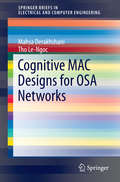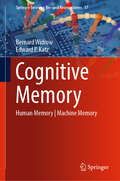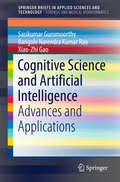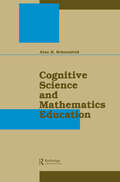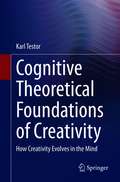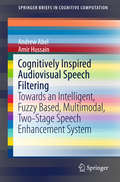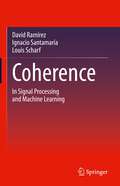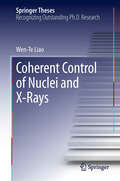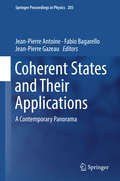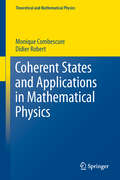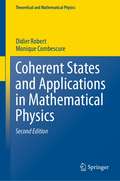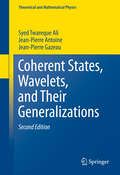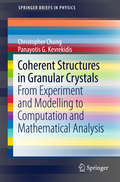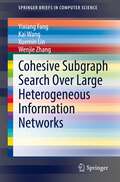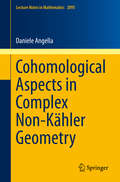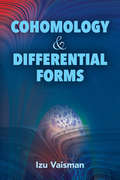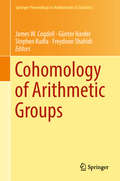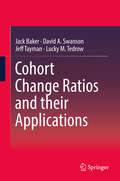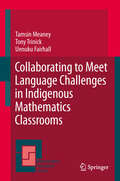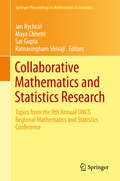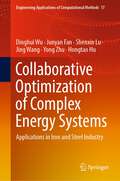- Table View
- List View
Cognitive IoT: Emerging Technology towards Human Wellbeing (Intelligent Signal Processing and Data Analysis)
by J P Patra Gurudatta VermaThis book deals with a different research area of cognitive IoT and explains how machine learning algorithms can be applied for cognitive IoT. It deals with applications of cognitive IoT in this pandemic (COVID-19), applications for student performance evaluation, applications for human healthcare for chronic disease prediction, use of wearable sensors and review regarding their energy optimization and how cognitive IoT helps in farming through rainfall prediction and prediction of lake levels. Features: Describes how cognitive IoT is helpful for chronic disease prediction and processing of data gathered from healthcare devices. Explains different sensors available for health monitoring. Explores application of cognitive IoT in COVID-19 analysis. Discusses pertinent and efficient farming applications for sustaining agricultural growth. Reviews smart educational aspects such as student response, performance, and behavior and instructor response, performance, and behavior. This book aims at researchers, professionals and graduate students in Computer Science and Engineering, Computer Applications and Electronics Engineering, and Wireless Communications and Networking.
Cognitive MAC Designs for OSA Networks (SpringerBriefs in Electrical and Computer Engineering)
by Tho Le-Ngoc Mahsa DerakhshaniThis SpringerBrief presents recent advances in the cognitive MAC designs for opportunistic spectrum access (OSA) networks. It covers the basic MAC functionalities and MAC enhancements of IEEE 802. 11. Later chapters discuss the existing MAC protocols for OSA and classify them based on characteristic features. The authors provide new research in adaptive carrier sensing-based MAC designs tailored for OSA, which optimize spectrum utilization and ensure a peaceful coexistence of licensed and unlicensed systems. Analytically devised via optimization and game-theoretic approaches, these adaptive MAC designs are shown to effectively reduce collisions between both primary and secondary network users. Researchers and professionals working in wireless communications and networks will find this content valuable. This brief is also a useful study guide for advanced-level students in computer science and electrical engineering.
Cognitive Memory: Human Memory | Machine Memory (Springer Series on Bio- and Neurosystems #17)
by Bernard Widrow Edward P. KatzHow does human memory work? How does human pattern recognition work? The book’s motivation is twofold, to add to knowledge in the field of neuroscience, and to design a highly simplified cognitive memory constructed using software and existing electronic components. Readers are taken on an inspiring journey through the fundamentals of human memory, how it is constructed, and how it works in everyday life. The book goes more in-depth into the human side of cognitive memory — how seeing, hearing, walking and speaking works. Impairments in cognitive memory are also discussed. Lastly, the book sheds light on how meaning is extracted from sensory inputs and from stored data. This book is not without controversy. Neuroscientists accept the engrams (or memory traces) model that long-term memory is stored in the brain’s neural networks. The authors believe that long-term human memory is stored digitally, in the DNA of brain cells, and not in analog neural networks. Further, the authors believe that innate knowledge of humans and animals is inherited, transmitted from parents to offspring at the moment of conception. The single cell contains the innate knowledge in the DNA of its nucleus. Memory is stored in DNA. The brain’s neural networks are for access and retrieval of memory and not for actual storage. This book offers a unique, inspiring reading to researchers and other readers interested in the science of memory.
Cognitive Science and Artificial Intelligence: Advances and Applications (SpringerBriefs in Applied Sciences and Technology)
by Xiao-Zhi Gao Sasikumar Gurumoorthy Bangole Narendra Kumar RaoThis book presents interdisciplinary research on cognition, mind and behavior from an information processing perspective. It includes chapters on Artificial Intelligence, Decision Support Systems, Machine Learning, Data Mining and Support Vector Machines, chiefly with regard to the data obtained and analyzed in Medical Informatics, Bioinformatics and related disciplines. The book reflects the state-of-the-art in Artificial Intelligence and Cognitive Science, and covers theory, algorithms, numerical simulation, error and uncertainty analysis, as well novel applications of new processing techniques in Biomedical Informatics, Computer Science and its applied areas. As such, it offers a valuable resource for students and researchers from the fields of Computer Science and Engineering in Medicine and Biology.
Cognitive Science and Mathematics Education
by Alan H. SchoenfeldThis volume is a result of mathematicians, cognitive scientists, mathematics educators, and classroom teachers combining their efforts to help address issues of importance to classroom instruction in mathematics. In so doing, the contributors provide a general introduction to fundamental ideas in cognitive science, plus an overview of cognitive theory and its direct implications for mathematics education. A practical, no-nonsense attempt to bring recent research within reach for practicing teachers, this book also raises many issues for cognitive researchers to consider.
Cognitive Theoretical Foundations of Creativity: How Creativity Evolves in the Mind
by Karl TestorHow does creativity evolve in mind? This question leads a journey through neuroanatomical understanding and cognitive models. It thereby helps to figure out new approaches in decoding the process of creativity. These “aspects of the new” provide better understanding and constitute future research and insight of cognitive activities and creativity.
Cognitive Training: An Overview of Features and Applications
by Tilo Strobach Julia KarbachThe second edition of this book brings together a cutting edge international team of contributors to critically review the current knowledge regarding the effectiveness of training interventions designed to improve cognitive functions in different target populations. Since the publication of the first volume, the field of cognitive research has rapidly evolved. There is substantial evidence that cognitive and physical training can improve cognitive performance, but these benefits seem to vary as a function of the type and the intensity of interventions and the way training-induced gains are measured and analyzed. This book will address the new topics in psychological research and aims to resolve some of the currently debated issues. This book offers a comprehensive overview of empirical findings and methodological approaches of cognitive training research in different cognitive domains (memory, executive functions, etc.), types of training (working memory training, video game training, physical training, etc.), age groups (from children to young and older adults), target populations (children with developmental disorders, aging workers, MCI patients etc.), settings (laboratory-based studies, applied studies in clinical and educational settings), and methodological approaches (behavioral studies, neuroscientific studies). Chapters feature theoretical models that describe the mechanisms underlying training-induced cognitive and neural changes.Cognitive Training: An Overview of Features and Applications, Second Edition will be of interest to researchers, practitioners, students, and professors in the fields of psychology and neuroscience.
Cognitively Inspired Audiovisual Speech Filtering: Towards an Intelligent, Fuzzy Based, Multimodal, Two-Stage Speech Enhancement System (SpringerBriefs in Cognitive Computation #5)
by Amir Hussain Andrew AbelThis book presents a summary of the cognitively inspired basis behind multimodal speech enhancement, covering the relationship between audio and visual modalities in speech, as well as recent research into audiovisual speech correlation. A number of audiovisual speech filtering approaches that make use of this relationship are also discussed. A novel multimodal speech enhancement system, making use of both visual and audio information to filter speech, is presented, and this book explores the extension of this system with the use of fuzzy logic to demonstrate an initial implementation of an autonomous, adaptive, and context aware multimodal system. This work also discusses the challenges presented with regard to testing such a system, the limitations with many current audiovisual speech corpora, and discusses a suitable approach towards development of a corpus designed to test this novel, cognitively inspired, speech filtering system.
Cohabitation, Family & Society (Routledge Advances in Sociology #Vol. 36)
by Tiziana NazioThis book deals with the process of the diffusion of cohabitation in Europe and discusses its impact upon fundamental changes in family formation. It makes use of highly dynamic statistical modelling that takes into account both changes occurring along the life course (individuals’ biographies) and across birth cohorts of individuals (generational change) in a comparative perspective. It is thus innovative methodologically, but is written in such a way as to be easily readable by those with little knowledge of quantitative methods. The approach proposed is empirically tested on a selection of European countries: the social democratic Sweden, the conservative-corporatist France and West Germany, the former socialist East Germany, and the familistic Italy and Spain. The theory and its application are described in a clear and simple manner, making the arguments and their illustrations accessible to those from a variety of disciplines. The study shows evidence of the ‘contagiousness’ of cohabitation, providing new insights on a process relevant to many social science debates. It is thus directed to those interested in the mechanisms driving social and cultural change, the nature of demographic changes, as well as diffusion processes.
Coherence in Three-Dimensional Category Theory
by Nick GurskiDimension three is an important test-bed for hypotheses in higher category theory and occupies something of a unique position in the categorical landscape. At the heart of matters is the coherence theorem, of which this book provides a definitive treatment, as well as covering related results. Along the way the author treats such material as the Gray tensor product and gives a construction of the fundamental 3-groupoid of a space. The book serves as a comprehensive introduction, covering essential material for any student of coherence and assuming only a basic understanding of higher category theory. It is also a reference point for many key concepts in the field and therefore a vital resource for researchers wishing to apply higher categories or coherence results in fields such as algebraic topology or theoretical computer science.
Coherence: In Signal Processing and Machine Learning
by Louis Scharf David Ramírez Ignacio SantamaríaThis book organizes principles and methods of signal processing and machine learning into the framework of coherence. The book contains a wealth of classical and modern methods of inference, some reported here for the first time. General results are applied to problems in communications, cognitive radio, passive and active radar and sonar, multi-sensor array processing, spectrum analysis, hyperspectral imaging, subspace clustering, and related. The reader will find new results for model fitting; for dimension reduction in models and ambient spaces; for detection, estimation, and space-time series analysis; for subspace averaging; and for uncertainty quantification. Throughout, the transformation invariances of statistics are clarified, geometries are illuminated, and null distributions are given where tractable. Stochastic representations are emphasized, as these are central to Monte Carlo simulations. The appendices contain a comprehensive account of matrix theory, the SVD, the multivariate normal distribution, and many of the important distributions for coherence statistics. The book begins with a review of classical results in the physical and engineering sciences where coherence plays a fundamental role. Then least squares theory and the theory of minimum mean-squared error estimation are developed, with special attention paid to statistics that may be interpreted as coherence statistics. A chapter on classical hypothesis tests for covariance structure introduces the next three chapters on matched and adaptive subspace detectors. These detectors are derived from likelihood reasoning, but it is their geometries and invariances that qualify them as coherence statistics. A chapter on independence testing in space-time data sets leads to a definition of broadband coherence, and contains novel applications to cognitive radio and the analysis of cyclostationarity. The chapter on subspace averaging reviews basic results and derives an order-fitting rule for determining the dimension of an average subspace. These results are used to enumerate sources of acoustic and electromagnetic radiation and to cluster subspaces into similarity classes. The chapter on performance bounds and uncertainty quantification emphasizes the geometry of the Cramèr-Rao bound and its related information geometry.
Coherent Control of Nuclei and X-Rays (Springer Theses)
by Wen-Te LiaoNovel coherent light sources such as x-ray free-electron lasers open exciting prospects for the interaction of light with nuclei. The thesis "Coherent Control of Nuclei and X-rays" covers this still-developing field and proposes, in a daring attempt to revolutionize nuclear physics, three innovative schemes for taming nuclei using coherent effects. The theoretical explorations, which address control of nuclear quantum states, a nuclear memory for single photons in future photonic circuits, and optimized concepts for a nuclear clock, make use of new approaches at the borderline between nuclear physics and quantum dynamics. The result is a well written work, impressive in its stimulating style and promising ideas.
Coherent States and Their Applications: A Contemporary Panorama (Springer Proceedings in Physics #205)
by Fabio Bagarello Jean-Pierre Gazeau Jean-Pierre AntoineCoherent states (CS) were originally introduced in 1926 by Schrödinger and rediscovered in the early 1960s in the context of laser physics. Since then, they have evolved into an extremely rich domain that pervades virtually every corner of physics, and have also given rise to a range of research topics in mathematics.The purpose of the 2016 CIRM conference was to bring together leading experts in the field with scientists interested in related topics, to jointly investigate their applications in physics, their various mathematical properties, and their generalizations in many directions. Instead of traditional proceedings, this book presents sixteen longer review-type contributions, which are the outcome of a collaborative effort by many conference participants, subsequently reviewed by independent experts.The book aptly illustrates the diversity of CS aspects, from purely mathematical topics to physical applications, including quantum gravity.
Coherent States and Applications in Mathematical Physics (Theoretical and Mathematical Physics)
by Didier Robert Monique CombescureThis book presents the various types of coherent states introduced and studied in the physics and mathematics literature and describes their properties together with application to quantum physics problems. It is intended to serve as a compendium on coherent states and their applications for physicists and mathematicians, stretching from the basic mathematical structures of generalized coherent states in the sense of Perelomov via the semiclassical evolution of coherent states to various specific examples of coherent states (hydrogen atom, quantum oscillator, ...).
Coherent States and Applications in Mathematical Physics (Theoretical and Mathematical Physics)
by Didier Robert Monique CombescureThis second edition of the outstanding monograph on coherent states by Combescure and Robert published in 2012 is enriched with figures, historical information and numerical simulations and enlarged with five new chapters presenting important rigorous results obtained in the recent years. The new chapters include various applications such as to the time dependent Schroedinger equation and the Ehrenfest time, to the growth of norms and energy exchanges, to chaotic systems and classical systems with quantum ergodic behavior, and to open quantum systems, and to adiabatic decoupling for multicomponent systems Overall, this book presents the various types of coherent states introduced and studied in the physics and mathematics literature and describes their properties together with application to quantum physics problems. It is intended to serve as a compendium on coherent states and their applications for physicists and mathematicians, stretching from the basic mathematical structures of generalized coherent states in the sense of Perelomov via the semiclassical evolution of coherent states to various specific examples of coherent states (hydrogen atom, quantum oscillator, etc.). It goes beyond existing books on coherent states in terms of a rigorous mathematical framework
Coherent States, Wavelets, and Their Generalizations (Theoretical and Mathematical Physics)
by Jean-Pierre Gazeau Syed Twareque Ali Jean-Pierre AntoineThis second edition is fully updated, covering in particular new types of coherent states (the so-called Gazeau-Klauder coherent states, nonlinear coherent states, squeezed states, as used now routinely in quantum optics) and various generalizations of wavelets (wavelets on manifolds, curvelets, shearlets, etc. ). In addition, it contains a new chapter on coherent state quantization and the related probabilistic aspects. As a survey of the theory of coherent states, wavelets, and some of their generalizations, it emphasizes mathematical principles, subsuming the theories of both wavelets and coherent states into a single analytic structure. The approach allows the user to take a classical-like view of quantum states in physics. Starting from the standard theory of coherent states over Lie groups, the authors generalize the formalism by associating coherent states to group representations that are square integrable over a homogeneous space; a further step allows one to dispense with the group context altogether. In this context, wavelets can be generated from coherent states of the affine group of the real line, and higher-dimensional wavelets arise from coherent states of other groups. The unified background makes transparent an entire range of properties of wavelets and coherent states. Many concrete examples, such as coherent states from semisimple Lie groups, Gazeau-Klauder coherent states, coherent states for the relativity groups, and several kinds of wavelets, are discussed in detail. The book concludes with a palette of potential applications, from the quantum physically oriented, like the quantum-classical transition or the construction of adequate states in quantum information, to the most innovative techniques to be used in data processing. Intended as an introduction to current research for graduate students and others entering the field, the mathematical discussion is self-contained. With its extensive references to the research literature, the first edition of the book is already a proven compendium for physicists and mathematicians active in the field, and with full coverage of the latest theory and results the revised second edition is even more valuable.
Coherent Structures in Granular Crystals: From Experiment And Modelling To Computation And Mathematical Analysis (SpringerBriefs in Physics)
by Panayotis G. Kevrekidis Christopher ChongThis book summarizes a number of fundamental developments at the interface of granular crystals and the mathematical and computational analysis of some of their key localized nonlinear wave solutions. The subject presents a blend of the appeal of granular crystals as a prototypical engineering tested for a variety of diverse applications, the novelty in the nonlinear physics of its coherent structures, and the tractability of a series of mathematical and computational techniques to analyse them. While the focus is on principal one-dimensional solutions such as shock waves, traveling waves, and discrete breathers, numerous extensions of the discussed patterns, e.g., in two dimensions, chains with defects, heterogeneous settings, and other recent developments are discussed. The emphasis on the subject was motivated by models in condensed matter physics, ferroelectrics, high energy physics, and statistical mechanics, leading to developments in mathematical analysis, numerical computation and insights on the physical aspects of the model. The book appeals to researchers in the field, as well as for graduate and advanced undergraduate students. It will be of interest to mathematicians, physicists and engineers alike.
Cohesive Subgraph Search Over Large Heterogeneous Information Networks (SpringerBriefs in Computer Science)
by Wenjie Zhang Xuemin Lin Kai Wang Yixiang FangThis SpringerBrief provides the first systematic review of the existing works of cohesive subgraph search (CSS) over large heterogeneous information networks (HINs). It also covers the research breakthroughs of this area, including models, algorithms and comparison studies in recent years. This SpringerBrief offers a list of promising future research directions of performing CSS over large HINs.The authors first classify the existing works of CSS over HINs according to the classic cohesiveness metrics such as core, truss, clique, connectivity, density, etc., and then extensively review the specific models and their corresponding search solutions in each group. Note that since the bipartite network is a special case of HINs, all the models developed for general HINs can be directly applied to bipartite networks, but the models customized for bipartite networks may not be easily extended for other general HINs due to their restricted settings. The authors also analyze and compare these cohesive subgraph models (CSMs) and solutions systematically. Specifically, the authors compare different groups of CSMs and analyze both their similarities and differences, from multiple perspectives such as cohesiveness constraints, shared properties, and computational efficiency. Then, for the CSMs in each group, the authors further analyze and compare their model properties and high-level algorithm ideas.This SpringerBrief targets researchers, professors, engineers and graduate students, who are working in the areas of graph data management and graph mining. Undergraduate students who are majoring in computer science, databases, data and knowledge engineering, and data science will also want to read this SpringerBrief.
Cohomological Aspects in Complex Non-Kähler Geometry (Lecture Notes in Mathematics #2095)
by Daniele AngellaIn these notes, we provide a summary of recent results on the cohomological properties of compact complex manifolds not endowed with a Kähler structure. On the one hand, the large number of developed analytic techniques makes it possible to prove strong cohomological properties for compact Kähler manifolds. On the other, in order to further investigate any of these properties, it is natural to look for manifolds that do not have any Kähler structure. We focus in particular on studying Bott-Chern and Aeppli cohomologies of compact complex manifolds. Several results concerning the computations of Dolbeault and Bott-Chern cohomologies on nilmanifolds are summarized, allowing readers to study explicit examples. Manifolds endowed with almost-complex structures, or with other special structures (such as, for example, symplectic, generalized-complex, etc. ), are also considered.
Cohomology and Differential Forms
by Izu VaismanThis monograph explores the cohomological theory of manifolds with various sheaves and its application to differential geometry. Based on lectures given by author Izu Vaisman at Romania's University of Iasi, the treatment is suitable for advanced undergraduates and graduate students of mathematics as well as mathematical researchers in differential geometry, global analysis, and topology.A self-contained development of cohomological theory constitutes the central part of the book. Topics include categories and functors, the Čech cohomology with coefficients in sheaves, the theory of fiber bundles, and differentiable, foliated, and complex analytic manifolds. The final chapter covers the theorems of de Rham and Dolbeault-Serre and examines the theorem of Allendoerfer and Eells, with applications of these theorems to characteristic classes and the general theory of harmonic forms.
Cohomology of Arithmetic Groups: On the Occasion of Joachim Schwermer's 66th Birthday, Bonn, Germany, June 2016 (Springer Proceedings in Mathematics & Statistics #245)
by James W. Cogdell Günter Harder Stephen Kudla Freydoon ShahidiThis book discusses the mathematical interests of Joachim Schwermer, who throughout his career has focused on the cohomology of arithmetic groups, automorphic forms and the geometry of arithmetic manifolds. To mark his 66th birthday, the editors brought together mathematical experts to offer an overview of the current state of research in these and related areas. The result is this book, with contributions ranging from topology to arithmetic. It probes the relation between cohomology of arithmetic groups and automorphic forms and their L-functions, and spans the range from classical Bianchi groups to the theory of Shimura varieties. It is a valuable reference for both experts in the fields and for graduate students and postdocs wanting to discover where the current frontiers lie.
Cohort Change Ratios and their Applications
by Jack Baker David A. Swanson Jeff Tayman Lucky M. TedrowThis textbook focuses on the cohort change ratio (CCR) method. It presents powerful, yet relatively simple ways to generate accurate demographic estimates and forecasts that are cost efficient and require fewer resources than other techniques. The concepts, analytical frameworks, and methodological tools presented do not require extensive knowledge of demographics, mathematics, or statistics. The demographic focus is on the characteristics of populations, especially age and sex composition, but these methods are applicable estimating and forecasting other characteristics and total population. The book contains more traditional applications such as the Hamilton-Perry method, but also includes new applications of the CCR method such as stable population theory. Real world empirical examples are provided for every application; along with excel files containing data and program code, which are accessible online. Topics covered include basic demographic measures, sources of demographic information, forecasting and estimating (both current and historical) populations, modifications to current methods, forecasting school enrollment and other characteristics, estimating life expectancy, stable population theory, decomposition of the CCR into its migration and mortality components, and the utility of the CCR. This textbook is designed to provide material for an advanced undergraduate or graduate course on demographic methods. It can also be used as a supplement for other courses including applied demography, business and economic forecasting and market research.
Collaborating to Meet Language Challenges in Indigenous Mathematics Classrooms (Mathematics Education Library #52)
by Tamsin Meaney Tony Trinick Uenuku FairhallLanguage can be simultaneously both a support and a hindrance to students' learning of mathematics. When students have sufficient fluency in the mathematics register so that they can discuss their ideas, they become chiefs who are able to think mathematically. However, learning the mathematics register of an Indigenous language is not a simple exercise and involves many challenges not only for students, but also for their teachers and the wider community. Collaborating to Meet Language Challenges in Indigenous Mathematics Classrooms identifies some of the challenges--political, mathematical, community based, and pedagogical-- to the mathematics register, faced by an Indigenous school, in this case a Mäori immersion school. It also details the solutions created by the collaboration of teachers, researchers and community members.
Collaborative Mathematics and Statistics Research: Topics from the 9th Annual UNCG Regional Mathematics and Statistics Conference (Springer Proceedings in Mathematics & Statistics #109)
by Jan Rychtář Sat Gupta Ratnasingham Shivaji Maya ChhetriThis volume contains rigorously reviewed papers on the topics presented by students at The 9th Annual University of North Carolina at Greensboro Regional Mathematics and Statistics Conference (UNCG RMSC) that took place on November 2, 2013. All papers are coauthored by student researchers and their faculty mentors. This conference series was inaugurated in 2005, and it now attracts over 150 participants from over 30 universities from North Carolina and surrounding states. The conference is specifically tailored for students to present their research projects that encompass a broad spectrum of topics in mathematics, mathematical biology, statistics, and computer science.
Collaborative Optimization of Complex Energy Systems: Applications in Iron and Steel Industry (Engineering Applications of Computational Methods #17)
by Jing Wang Yong Zhu Dinghui Wu Junyan Fan Shenxin Lu Hongtao HuThis book mainly focuses on the multi-media energy prediction technology and optimization methods of iron and steel enterprises. The technical methods adopted include swarm intelligence algorithm, neural network, reinforcement learning, and so on. Energy saving and consumption reduction in iron and steel enterprises have always been a research hotspot in the field of process control. This book considers the multi-media energy balance problem from the perspective of system, studies the energy flow and material flow in iron and steel enterprises, and provides energy optimization methods that can be used for planning, prediction, and scheduling under different production scenes. The main audience of this book is scholars and graduate students in the fields of control theory, applied mathematics, energy optimization, etc.

